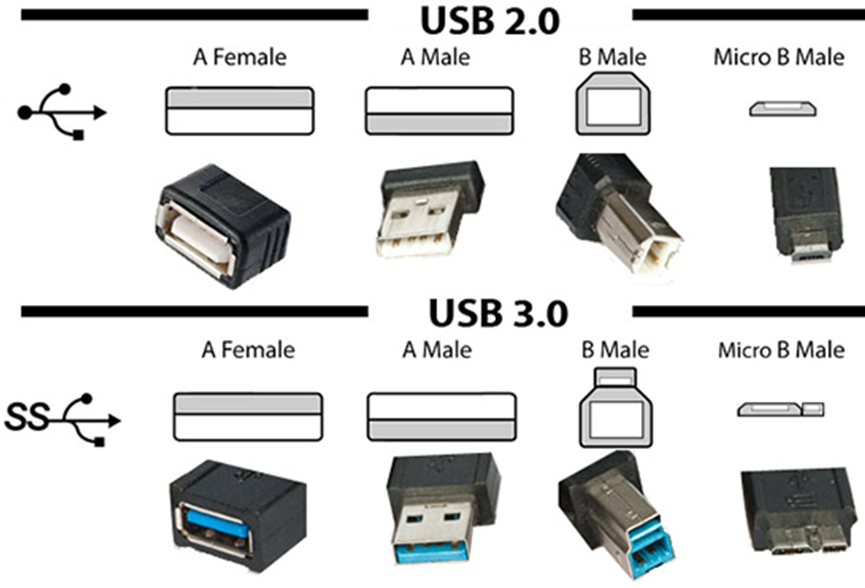Introduction
Digital interfaces allow scientific cameras (and other imaging or microscopy hardware) to communicate with computers, typically for data transfer so that images acquired during experimentation can be stored for analysis and processing.
With camera hardware increasing in speed and field of view (FOV), experiments can produce large amounts of data, especially when looking at multiple dimensions such as time-lapse, XY scanning, Z-stacking for 3D imaging, multichannel imaging, and more. This means it is vital to know the pros and cons of certain digital interfaces, in order to match flexibility, compatibility, and data transfer rate.
Teledyne Photometrics CCD and CMOS cameras typically use either universal serial bus (USB) or external peripheral component interconnect express (PCIe) cables, both of which are explored in this article.
USB
USB needs no introduction, as it has become an industry-standard connector for storage, power, peripherals, and data transfer. From the launch of USB as a platform in 1996, there have been a number of different generations and iterations of USB hardware, which have changed names over the years and been subject to some re-branding. This section covers some generational changes in USB while demystifying the nomenclature.
From 1996 to 2014 there have been a number of different USB generations, as outlined below:
- USB 1.0: Introduced Jan 1996, max speed 12 Mbit/s
- USB 2.0: Introduced April 2000, max speed 480 Mbit/s
- USB 3.0: Introduced Nov 2008, max speed 5 Gbit/s

Each new generation introduced greater speed and transfer rates along with more efficient power usage. Rather than move onto a new generation, the next upgrade to USB came in the form of specification USB 3.1 (introduced July 2013, max speed 10 Gbit/s), which featured twice the speed as USB 3.0. Due to the success of USB 3.1, USB 3.0 was retroactively renamed, as seen in Table 1.
Table 1: The different naming systems for USB digital interfaces
| Original name | New name | USB branding | Max speed |
| USB 3.0 | USB 3.1 Gen 1 | SuperSpeed USB | 5 Gbit/s |
| USB 3.1 | USB 3.1 Gen 2 | SuperSpeed USB 10Gbps | 10 Gbit/s |
Following the release of USB 3.2 in Sep 2017, this naming scheme was again changed, from USB 3.1 Gen X to USB 3.2 Gen X. Overall, this means that USB 3.2 Gen 2 refers to what was originally USB 3.1, a USB system with a maximum transfer rate of 10 Gbit/s.
At Teledyne Photometrics we follow the latest trends in USB technology, and our cameras typically use the fastest USB data cables currently available, with newer cameras like the Prime BSI Express and Kinetix using USB 3.2 Gen 2, a USB C type reversible cable for easy usage.
PCIe
A computer motherboard typically contains several expansion slots for modular peripherals (such as RAM, a GPU, sound card, or additional digital interface) that can be swapped in and out, these are known as PCI Express slots.
However, PCIe can also refer to the external PCIe cable, a multi-purpose interface that has been widely adopted across the computing industry for the high data transfer rate, as seen in Fig. 2.

PCIe currently has six iterations with the data transfer rate doubling each time, resulting in large data transfer rates, suitable for experiments that produce gigabytes to terabytes of information with each imaging session.
USB vs PCIe
The overall maximum speed of a scientific camera is related to how much data the camera sensor can output, but if the camera can output data faster than the interface is capable of transferring it, it creates a bottleneck in the imaging system. As a general rule, each imaging system is only as fast as the slowest component, which means that researchers using imaging systems that need to operate at high throughput or high speed, need the more efficient and fastest data transfer technologies.
Historically, scientific cameras have used a variety of technologies to interface with computers and digital storage systems, from frame grabbers (expansion cards that captured individual frames) to Thunderbolt and GigE connections to allow the use of the full speed of the camera to transfer to the computer. However, these technologies are bulky, often need additional cards for the PC to have the correct interfaces, and can be difficult to use as in some cases the camera will need to load before the PC for the interface to function. This makes USB an attractive alternative as it is easy to use, flexible, and ubiquitous across PCs.
However, USB has a lower data rate than some of these alternatives, especially PCIe, as outlined in Fig.3 which demonstrates the differences between different generations of USB and PCIe over time.

Teledyne Photometrics sCMOS cameras typically offer either a USB or a PCIe version, with more recent cameras such as the Kinetix offering both in one system, with the PCIe setup delivering greater speeds and framerates due to the ability to push more data down the cable during high-speed acquisition.
Summary
Overall, USB is a flexible and ubiquitous option that researchers already have access to, and recent versions can achieve 10 Gbps speeds that are suitable for applications such as cell documentation, or other imaging experiments that don’t require high speeds, either due to a lack of dynamic motion in the sample, or the need for a long exposure due to a low signal level, which also limits speed. If speed is a necessity and the imaging computer has a free PCIe slot, PCIe external interfaces are more suitable due to the significantly higher data rate and ability to run high speed cameras such as the Kinetix at full speeds.
